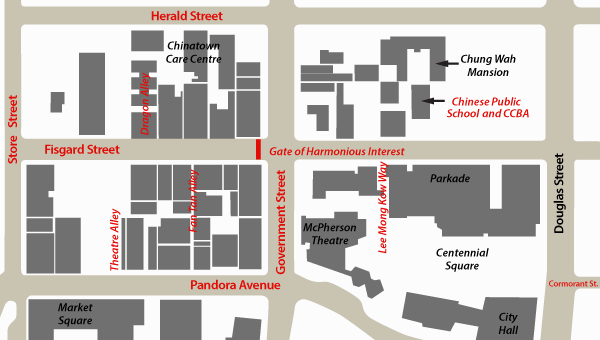- Home
- History
- Community
- Organizations
- Chinese Consolidated Benevolent Association
- Victoria Chinese Canadian Veterans Association
- Chinese Public School
- Clan Associations
- County Assocations
- Dialect Assocations
- Friendship Associations
- Political Organizations
- Recreational Associations
- Religious Organizations
- Women's Associations
- Other Organizations
- People
- Resources
- Contact
Government Street
Thoroughfare across Chinatown
As Chinatown expanded north from the 1880s, and extended east until the early 1910s, Government Street served as a route through blocks of buildings owned, leased or rented by Chinese residents. The central location of Government Street in the early twentieth century was highlighted by arches built by the Chinese community spanning this street in 1906 and 1912 to welcome governor generals the Earl Grey and the Duke of Connaught on their tours of Victoria.
The black and white photo shows the two-storey brick building that stood at the southeast corner of Government and Fisgard, adjacent to the old Pantages Theatre (Royal BC Museum, BC Archives, I-31952, 1963). In 2012, there is an open courtyard in this corner, with a Starbucks to the left and the McPherson Playhouse, which incorporates some of the Pantages Theatre building, to the right (Photo by Charles Yang, 2012).
A number of heritage buildings have survived on Government Street that were built to house Chinese businesses or associations from the 1890s to the 1910s. The oldest of these, on a lot purchased by Chan Tong Ork and Chan Tong Yue in 1891 for $10,000, was completed in 1897. This building at 1710-1714 Government Street, designed by Thomas Hooper, contains two stores on the main floor, tenements at the top, and a short “cheater floor” or second floor mezzanine in the middle. According to journalist Ian Granville, these short second floors were a design feature that made its way from Portugal and Italy to Southern China and into the Chinatowns of western North America as a storage space and a way of controlling temperature by venting hot air upwards and out through windows in the mezzanine. At the corner of Government and Fisgard streets, the Lee Block was built in 1910 by Lee Yan, Lee Cheong and Lee Woy. Designed by architect C. Elwood Watkins, this building was also constructed with a short second floor mezzanine above the main floor commercial space. In the two full upper floors, there are offices, which have been occupied by the Dart Coon Club and the Wong Sheung Kung-Fu Club, and tenements.
The Lee Block building, photographed in 1911, a year after it was built (City of Victoria Archives, M09088). The second photo shows the same building a century later (Photo by Charles Yang, 2012).
Located across Government Street from the Tong Yue and Tong Ork Building are the adjacent Yen Wo Society Building and the previous headquarters of the Chinese Empire Reform Association, two organizations that are described elsewhere on this website. The Yen Wo Society was founded by Hakka natives from China in 1905 and constructed its headquarters at 1713 Government in 1912. This building houses the Tam Kung Temple in the third floor. The Chinese Empire Reform Association (CERA), established in Victoria in July 1899, built its headquarters in 1905. Once the Republic of China was established in 1912, the CERA lost its purpose and its building was divided into two parts and purchased by different owners, including the Lung Kong Kung Shaw association.
The face of Government Street has changed over time as some buildings were demolished and replaced with other structures or open spaces. On the northeast corner of Government and Fisgard, Mrs. Maude Dorothy Bishop owned a few brick buildings that she rented to Chinese tenants. In the 1960s, these buildings were demolished. A gas station, and now the bakery and deli Quan Valdez, have successively stood in this location. On the southeast corner of Government and Fisgard, stood a two-storey brick building with shops on the lower level and apartments on the second floor. Centennial Square was created behind this building in 1962. Still standing in 1963, this building was likely demolished in the process of transforming the adjacent Pantages Theatre into the McPherson Playhouse in 1965.
Sources
Granville, Ian. “Secret City: On Buildings Being John Malkovich in Chinatown.” Scout Magazine, 21 July 2011. http://scoutmagazine.ca/2011/07/21/secret-city-on-buildings-being-john-m... (accessed 25 September 2012).
Lai, Chuen-yan David. Arches in British Columbia. Victoria: Sono Nis Press, 1982.
Lai, David Chuenyan. The Forbidden City within Victoria: Myth, Symbol and Streetscape of Victoria’s Earliest Chinatown. Victoria: Orca Book Publishers, 1991.
“Lee Block.” Canada’s Historic Places.
http://www.historicplaces.ca/en/rep-reg/place-lieu.aspx?id=14893&pid=0 (accessed 25 September 2012).
“On Hing Brothers Building.” Canada’s Historic Places. http://www.historicplaces.ca/en/rep-reg/place-lieu.aspx?id=14894 (accessed 25 September 2012).
“Yen Wo Society Building.” Canada’s Historic Places.
http://www.historicplaces.ca/en/rep-reg/place-lieu.aspx?id=14971&pid=0 (accessed 25 September 2012).


